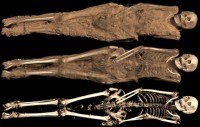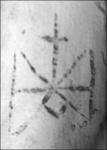 Researchers have discovered a unique Christian tattoo on the inner thigh of a mummy unearthed in a cemetery along the banks of the Nile in Sudan nine years ago. The woman, who was 5’2″ tall and between 20 and 35 years old at the time of her death, was wrapped in a linen and wool shroud and buried around 700 A.D. The arid heat of the desert naturally mummified her, preserving some soft tissues like skin and internal organs. The skin of her inner thigh is so well preserved that the ink is still visible to the naked eye, but it’s quite faint. It wasn’t until last year when the mummy was given a CT scan at a London hospital and photographed with infra-red reflectography that British Museum archaeologists were able to identify the tattoo as a monogram of the letters Μιχαήλ, meaning Michael.
Researchers have discovered a unique Christian tattoo on the inner thigh of a mummy unearthed in a cemetery along the banks of the Nile in Sudan nine years ago. The woman, who was 5’2″ tall and between 20 and 35 years old at the time of her death, was wrapped in a linen and wool shroud and buried around 700 A.D. The arid heat of the desert naturally mummified her, preserving some soft tissues like skin and internal organs. The skin of her inner thigh is so well preserved that the ink is still visible to the naked eye, but it’s quite faint. It wasn’t until last year when the mummy was given a CT scan at a London hospital and photographed with infra-red reflectography that British Museum archaeologists were able to identify the tattoo as a monogram of the letters Μιχαήλ, meaning Michael.
This is an exceptionally rare find. It’s the first tattoo of any kind found from this period in the Nile Valley. Michael was the patron saint of Christian medieval Sudan, so his name is invoked frequently in inscriptions. The monogram, which stacks the letters of Michael’s name so it looks almost like an upside angel, has been found engraved on stele and in graffiti on churches from that time, but this is the first tattoo of the symbol ever discovered.

 The purpose of the tattoo is, of course, unknown, since the only person who could tell us has been dead for 1,300 years. I imagine it had much the same purpose as religious iconography has in tattoos today: expressing reverence, faith, or asking for the intercession of the saint. It could also have been a protective invocation, in the same way that words from the Christian gospels were used to ward off evil in the 12th century Makurian crypt found at the archaeological site of Old Dongola, Sudan.
The purpose of the tattoo is, of course, unknown, since the only person who could tell us has been dead for 1,300 years. I imagine it had much the same purpose as religious iconography has in tattoos today: expressing reverence, faith, or asking for the intercession of the saint. It could also have been a protective invocation, in the same way that words from the Christian gospels were used to ward off evil in the 12th century Makurian crypt found at the archaeological site of Old Dongola, Sudan.
I wasn’t able to found out where precisely she was discovered — the Nile runs through all of modern Sudan and there are many archaeological sites along its banks — but my best guess is that it was one of the Merowe Dam Archaeological Salvage Project excavations which focused on several medieval Christian cemeteries threatened by the construction of a dam at the Fourth Cataract (the most impassable of the Nile’s rapids). The opening scene in the Telegraph’s video looks like the Fourth Cataract where the rapids have carved out several small islands, some of which have Christian cemeteries. If that is the location, it’s south of Old Dongola, but still in the Kingdom of Makuria.
[youtube=http://youtu.be/57sTV-G8TcU&w=430]
It is not clear who did the tattoo in ancient Sudan, and whether it was visible to other natives.
High up on her inner thigh, it may or may not have been out of view. And for all its scientific expertise, the British Museum admits to being unclear as to what exactly was the fashionable length of skirt worn by an ordinary Nile dwelling female in AD 700.
I don’t see her inner thigh tattoo being designed for public display. It seems like a deliberately private location no matter how short skirts may have been in Sudan 1,300 years ago. It’s going to be on public display now, though. This mummy is the youngest of eight from various periods in the Nile Valley that will be features in the British Museum’s Ancient Lives: New Discoveries. The show runs from May 22nd through November 30th and will use interactive technology to tell the stories of these eight people’s lives and deaths.
Glad this is not about a ‘mummified nuptial fruit cake’, which brings me back to this one :confused: : At not even 158cm our dried Sudanese sister was not entirely tall, nor did she get very old with her mere 20 to 36 years of age. Did, therefore, the primary source reveal anything about further personal details ? – Was she a ‘sinner’, a ‘saint’, or naturally just ‘something in between’ ?
In other words, a bit of more context would be nice to have. Here, it seems to be indeed a ‘christian’ one, as the ‘patibulum’ is not part of one of these greek letters. Thus, do not expect a ‘lower back tattoo’ in this case, i.e. there are no medieval ‘ass antlers’. One might wonder, however, who would have applied such a ‘St. Michael’ tattoo. My guess would be that she had been laid to rest in some sort of crypt. To conclude, ‘Ancient Lives: New Discoveries’ sounds at least promising.
Makes me wonder how tall was the avargage woman back then? I’m 5’1″,considered short now-a-days.I would have thought 5’2″ would have been very tall in 700ad.